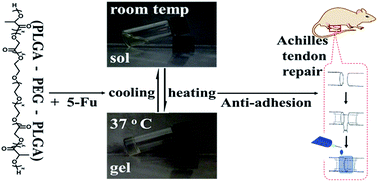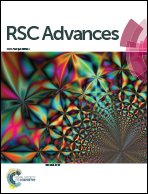5-Fluorouracil loaded thermosensitive PLGA–PEG–PLGA hydrogels for the prevention of postoperative tendon adhesion
Abstract
Prevention of adhesion after tendon repair surgery is of considerable importance during tendon healing; however, current clinical outcomes are still not fully satisfactory. In this study, thermosensitive 5-fluorouracil (5-Fu) loaded PLGA–PEG–PLGA hydrogels were used as injectable physical barriers for the prevention of tissue adhesion during tendon healing and inhibition of fibroblast proliferation. The 5-Fu-loaded hydrogels showed a sol–gel–precipitation phase transition with increasing temperature, and the hydrogels displayed the maximum storage moduli at around physiological temperature. The sustained release of 5-Fu from the hydrogels lasted over 7 days. The PLGA–PEG–PLGA hydrogels degraded within 4 weeks after subcutaneous injection into rats, and showed acceptable biocompatibility in vivo. The anti-adhesion efficacy of the hydrogels, with or without 5-Fu, during the Achilles tendon healing of rats was evaluated by macroscopic and histological analysis. It was found that the group treated with 5-Fu-loaded hydrogels showed a significant inhibition of adhesion formation when compared to the untreated group or the group treated with the hydrogels only. Therefore, the 5-Fu-loaded injectable hydrogels hold potential as efficient physical barriers for the prevention of adhesion formation during Achilles tendon healing.


 Please wait while we load your content...
Please wait while we load your content...